Here are some excellent images I found in 1:6 scale (about the size of a original G. I. Joe). :


As I continued my research I discovered that the kilt of the 42nd is much darker than other patterns:

Whenever I do a new type of figure or a figure where I am not sure of the correct colors to use, I paint a "test" figure. I will use either extra figures I'm not using or one of the figures that will be part of the unit (after all if you make a mistake, just paint over it!). This allows me to write down which paints I use on what and to have a "pattern" to look at a copy.
As I started to paint my test patterns for the kilt of the 42nd, I soon realized after a couple of tries that the kilt was going to be too dark for the wargames table. By that I mean, when looking at the figure from a gaming distance, I could not see any details on the kilt; it was too dark. I have run into this before with other figures, especially in the 15mm scale. To make the figures look presentable, it is often necessary to lighten the colors so the details or colors can be seen. After experimenting, I came up with the following tutorial for the kilts of the 42nd in 25mm/28mm scale:
 Paint the entire kilt a dark green. I primarily use GW's paints. After the figures were primed black, I used Dark Angel Green as the base color.
Paint the entire kilt a dark green. I primarily use GW's paints. After the figures were primed black, I used Dark Angel Green as the base color. Paint thick black horizontal and vertical stripes. Don't paint the stripes too close to each other as a thinner stripe is going to be painted between them later. If you are not used to painting stripes, practice on some spare paper or cardboard until you are confident that you can get the lines pretty straight. They don't have to be exact; at this scale you won't be able to tell the difference. I always tell myself it's a fold in the fabric!
Paint thick black horizontal and vertical stripes. Don't paint the stripes too close to each other as a thinner stripe is going to be painted between them later. If you are not used to painting stripes, practice on some spare paper or cardboard until you are confident that you can get the lines pretty straight. They don't have to be exact; at this scale you won't be able to tell the difference. I always tell myself it's a fold in the fabric! Paint a blue stripe over the black stripes. Don't use a blue that is too light; I used Royal Blue for my color.
Paint a blue stripe over the black stripes. Don't use a blue that is too light; I used Royal Blue for my color. Paint some lighter green in the dark green squares but don't cover up the dark green completely; this will give it a nice shaded effect. I used Snot Green (yeah, love the names GW uses for their paints).
Paint some lighter green in the dark green squares but don't cover up the dark green completely; this will give it a nice shaded effect. I used Snot Green (yeah, love the names GW uses for their paints). Carefully(!) paint a thin vertical and horizontal stripe to intersect the green squares. Don't worry if your lines are not exactly straight; again at this scale you won't be able to tell the difference. Before you know it, you have a pretty good government pattern kilt for your rank and file men in skirts.
Carefully(!) paint a thin vertical and horizontal stripe to intersect the green squares. Don't worry if your lines are not exactly straight; again at this scale you won't be able to tell the difference. Before you know it, you have a pretty good government pattern kilt for your rank and file men in skirts. Here is the result of the kilt pattern I used on Highlanders manufactured by Wargames Foundry in 28mm.
Here is the result of the kilt pattern I used on Highlanders manufactured by Wargames Foundry in 28mm. Figures are not quite finished but since I have a couple days off from work, I think I'll be able to get them finished this weekend.
Figures are not quite finished but since I have a couple days off from work, I think I'll be able to get them finished this weekend. This is an Officer figure by Front Rank Miniatures. This is going to be the mighty Captain Coll M'Dougall leading the highland charge into the face of the French invaders of Spain and Portugal!
This is an Officer figure by Front Rank Miniatures. This is going to be the mighty Captain Coll M'Dougall leading the highland charge into the face of the French invaders of Spain and Portugal!Yes, I do have a CD of the Royal Highland Regiment Pipes and Drums . . . and yes I play it when any of my Highlander units attack.


Incredible - I thought that 1st pic of the Royal Highlander from the 42nd Regiment of Foot was actually a photo of a real person ! I wish I could get my miniatures looking like that. I guess the backdrop helps.
ReplyDeleteYou certainly have an eye for detail, I admire your commitment. Keep us updated and tanks for sharing on your blog.
Sigmar
my Gallery
my Battle Reports
Great post, useful tips on painting tartan, thanks.
ReplyDeleteRegards,
Matt